INTRODUCTION
To better understand the intricacies of disease transmission between domestic sheep and bighorn sheep, it helps to have geographic/taxonomic context on the assortment of North American wild sheep. Valdez and Krausman summarize the allure of wild sheep and their habitats:
“Mountain sheep . . . are one of the most striking large mammals in North America. Simply observing them is an exciting and gratifying aesthetic experience. Mountain sheep epitomize wilderness. They occupy some of the most inaccessible, rugged, and spectacular habitats in North America. Their ability to negotiate precipitous terrain is legendary” (1999, 3).
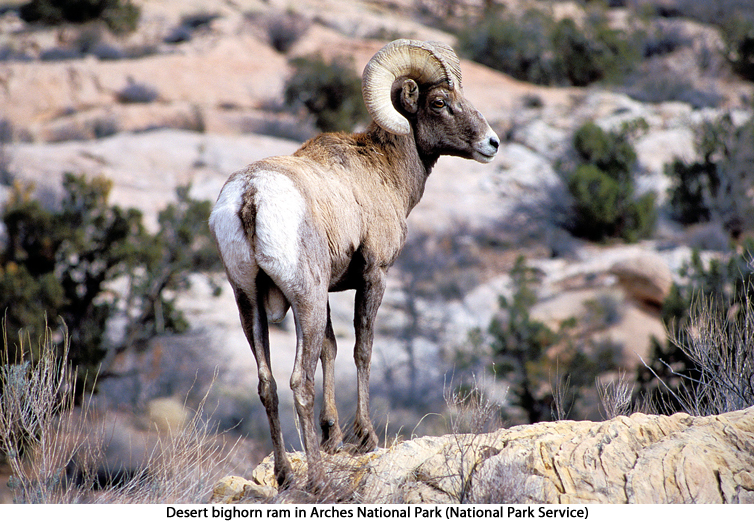
North American wild sheep generally only live in areas with suitable escape terrain (often steep cliffs, rocky outcrops, and slopes >60%). Such terrain allows sheep to place obstacles between themselves and pursuing danger. Thus, wild sheep are limited to habitat islands. They may only graze strips of land near escape terrain. They also prefer open country without tall vegetation that could block their view of predators (Valdez and Krausman 1999).
Several varieties of wild sheep exist in North America. Despite the label “bighorn” being applied to one species, not all wild sheep have big horns. Ewes have smaller horns than rams, which can grow massive, curling horns (Toweill and Geist 1999). Wild sheep share many behaviors, so varieties primarily differ via appearance and habitat (Valdez and Krausman 1999; Toweill and Geist 1999).
THINHORN SHEEP
Thinhorns (Ovis dalli) live in large swaths of contiguous mountain habitat in Alaska and northwest Canada. They have horns that are generally thinner and wider-flaring than those of other North American wild sheep (Toweill and Geist 1999). The thinhorn group includes the Dall’s sheep (O. d. dalli) and Stone’s sheep (O. d. stonei) (Valdez and Krausman 1999).
Dall’s sheep sport white hair coats and live in “Alaska, the Yukon, the western Northwest Territories, and . . . extreme [northwest] British Columbia” (Toweill and Geist 1999, 42). Stone’s sheep coloration varies, encompassing shades of gray and dark brown with patches of white. Stone’s sheep occur in northern British Columbia and south-central Yukon Territory (Toweill and Geist 1999). Thinhorn ewes can weigh about 50 kg (110 lbs) with rams weighing about 75 kg (165 lbs). Some Dall’s sheep rams may reach over 113 kg (249 lbs) (Valdez and Krausman 1999).
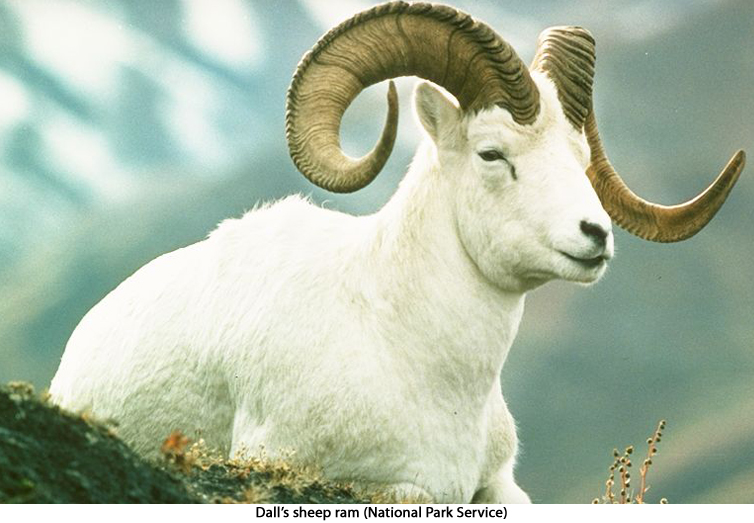
While bighorns in the Rocky Mountains periodically experience respiratory disease breakouts, thinhorn sheep do not. This may be because they live in regions that have not hosted widespread domestic sheep grazing (WAFWA 2007).
BIGHORN SHEEP
Introduction
In the western U.S., bighorns inhabit: mountains, canyons, rimrock, and badlands. All bighorns carry brown hair coats with white muzzles and white rump patches. Weights vary by subspecies and can range from 34-136 kg (75-300 lbs). Compared to thinhorns, bighorns live in more reduced, scattered, and isolated populations (Toweill and Geist 1999). According to Valdez and Krausman: “Dall’s and Stone’s sheep populations have remained relatively unimpacted by humans and have retained their historical distribution and numbers. [Bighorn] populations of southwestern Canada, the western United States, and northern Mexico have declined due to human impacts” (1999, 19).
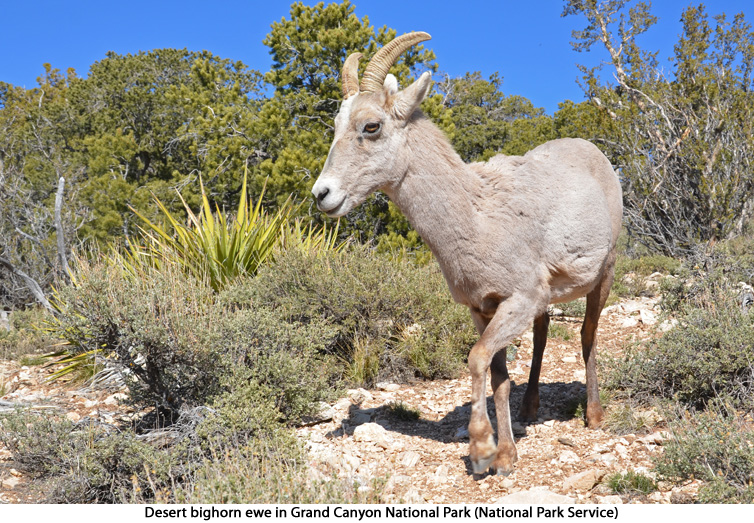
Bighorns in the continental U.S. live in: Arizona, California, Colorado, Idaho, Montana, Nebraska, Nevada, New Mexico, North Dakota, Oregon, South Dakota, Texas, Utah, Washington, and Wyoming. Bighorns largely live on public lands administered by the U.S. Forest Service and Bureau of Land Management. The domestic sheep disease risk varies based on subspecies and location (Arthur et al. 1999). Biologists have generally recognized five main North American bighorn subspecies (Toweill and Geist 1999; USFWS 2007).
Audubon’s
In historic times, the now-extinct Audubon’s bighorn (O. c. auduboni) lived in the badlands and river canyons of the Dakotas, Montana, Nebraska, and Wyoming (Valdez and Krausman 1999; Toweill and Geist 1999). Euro-American settlement caused the extinction of the Audubon’s bighorn. For years, it has been lamented as a lost subspecies. However, after more complete examinations of Audubon’s bighorn remains, biologists now believe the sheep were not significantly different from bighorns living in the Rockies and thus never warranted separate subspecies classification (French 2004).
Rocky Mountain
Rocky Mountain bighorns (O. c. canadensis) are the most abundant and largest bighorn subspecies (Valdez and Krausman 1999; Gildart 1997). They live throughout the Rockies from Alberta and British Columbia down to Arizona and New Mexico. Rocky Mountain bighorn rams have thicker and tighter-curling horns compared to other bighorn subspecies (Toweill and Geist 1999).
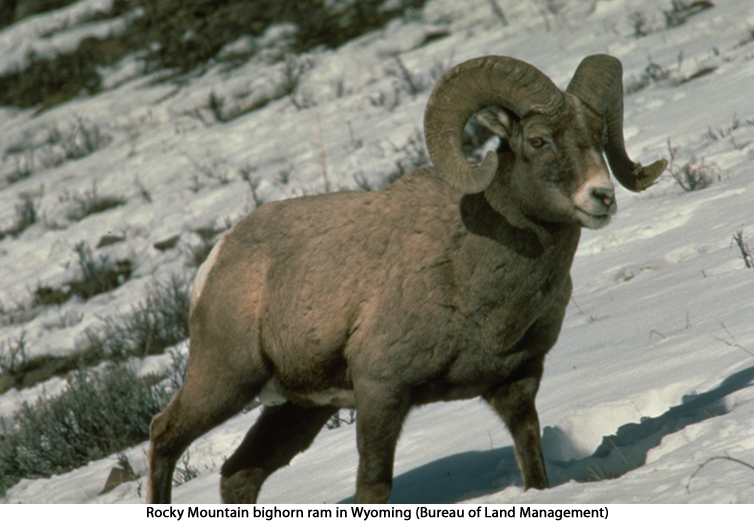
California
California bighorns (O. c. californiana) inhabit arid rimrock, mountain, and canyon country that stretches from the northern Great Basin to other high desert regions between the Cascades and the Rockies (Toweill and Geist 1999). Confirmed viable populations of California bighorns no longer live in California, though they used to inhabit the northeastern part of the state (Epps et al. 2003). According to Epps et al.: “Anecdotal reports [and the presence of a young ram in the Warner Mountains] have suggested that bighorn sheep may be appearing again in northeastern California” (2003, 25).
Biologists have considered California bighorns a distinct subspecies for years, but skull examinations and genetic evaluations indicate the sheep are indistinguishable from Rocky Mountain bighorns (Wehausen and Ramey II 2000). California bighorns usually look slightly different (leaner, wider-flaring horns on rams) than their Rocky Mountain relatives, but habitat seems a more likely explanation than genetics. California bighorns often live in lower elevations and feed on drier, sparser vegetation (Toweill and Geist 1999).
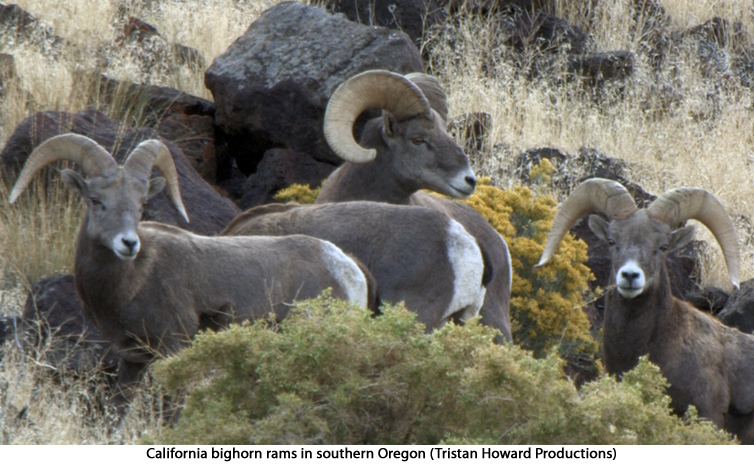
Desert
Desert bighorns inhabit the southwestern U.S., northern Mexico, and the Baja Peninsula. Based on skeletal measurements and coloration, biologists have generally recognized four varieties of desert bighorns: Nelson’s (O. c. nelsoni), Mexican (O. c. mexicana), Peninsular (O. c. cremnobates), and Weem’s (O. c. weemsi) (Toweill and Geist 1999). However, mitochondrial DNA analysis does not support recognizing multiple varieties of desert bighorns and suggests they are all one subspecies (Ramey II 1995). Generally, “desert bighorns are treated as a single group” (Toweill and Geist 1999, 158). Compared to other bighorns, desert bighorns are leaner and have reduced hair insulation (Toweill and Geist 1999).
In 1998, a population of desert bighorns in southern California’s Peninsular Ranges (extending from the San Jacinto Mountains down to the Mexican border) (USFWS 2000) was “listed as endangered under the distinct vertebrate population provision of the Endangered Species Act” (Epps et al. 2003, 30,34). Peninsular bighorns (O. c. cremnobates) were listed even after they were “no longer considered a valid subspecies” (Epps et al. 2003, 30). However, these listed bighorns were officially reclassified in 2009 as a distinct population segment of the Nelson’s desert bighorn (O. c. nelsoni) (USFWS 2011).
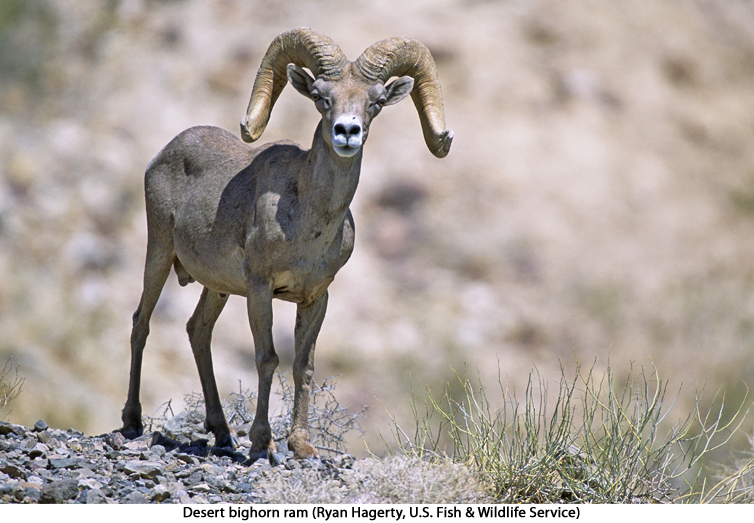
Sierra Nevada
Sierra Nevada bighorn sheep (O. c. sierrae) live in the central and southern Sierra Nevada Mountains of eastern California. Once classified as California bighorns, biologists have since recognized bighorns in the Sierra as a unique subspecies based on skull examinations and DNA analysis (USFWS 2007). These bighorns are more closely related to desert bighorns than Rocky Mountain bighorns (Toweill and Geist 1999). Sierra rams have very wide-flaring horns with relatively little curl (CDFG 2011).
In the 1990s, bighorns in the Sierra Nevada suffered severe population declines caused by mountain lion predation and harsh weather. In 2000, they gained federal endangered status as a distinct population segment of California bighorns (O. c. californiana) (USFWS 2007). However, in 2008, Sierra bighorns were officially reclassified as their own valid subspecies (O. c. sierrae) (DOI 2008).
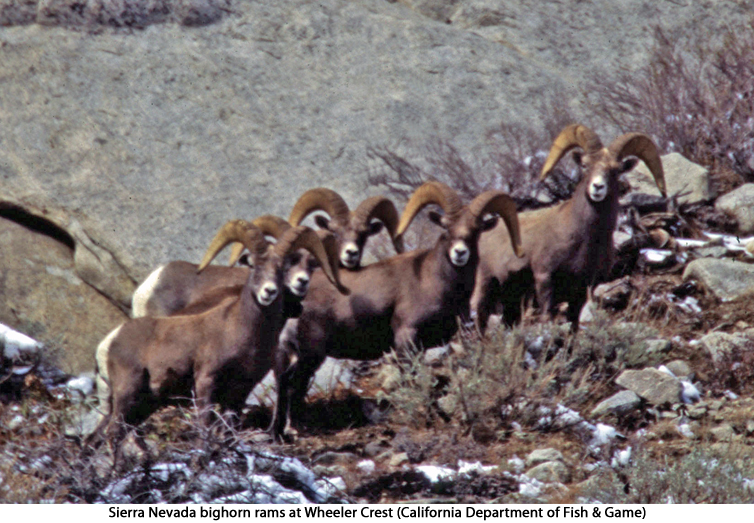
REFERENCES
Arthur, Steven M., Ian Hatter, Alasdair Veitch, John Nagy, Jean Carey, Jon T. Jorgenson, Raymond Lee, John Ellenberger, John Beecham, John J. McCarthy, Gary Schlichtemeier, Larry T. Gilbertson, Bill Dunn, Don Whittaker, Ted A. Benzon, Jim Karpowitz, George Tsukamato, Kevin Hurley, Steven G. Torres, Craig Mortimore, Mike Oehler, Patrick Cummings, Craig Stevenson, Eric Rominger, and Doug Humphreys. 1999. Appendix A: Wild sheep status questionnaires. In proceedings of 2nd North American Wild Sheep Conference, Reno, NV. April 6-9.
California Department of Fish and Game (CDFG). 2011. Sierra Nevada Bighorn Sheep Facts. http://www.dfg.ca.gov/snbs/SheepFacts.html (accessed December 30, 2011).
Department of the Interior (DOI). 2008. 50 CFR Part 17: Endangered and threatened wildlife and plants; Designation of critical habitat for the Sierra Nevada bighorn sheep (Ovis canadensis sierrae) and taxonomic revision. Federal Register 173, no. 151 (August): 45534-45604.
Epps, Clinton W., Vernon C. Bleich, John Wehausen, and Steven G. Torres. 2003. Status of bighorn sheep in California. In transactions of Desert Bighorn Council’s 47th Annual Meeting, St. George, UT. April 8-11.
French, Brett. 2004. The sheep that will not die: Clinging to the myth of Audubon’s bighorn. Montana Outdoors, November-December. http://fwp.mt.gov/mtoutdoors/HTML/articles/ 2004/audubonbighorn.htm (accessed June 5, 2012).
Toweill, Dale E., and Valerius Geist. 1999. Return of royalty: Wild sheep of North America. Missoula, MT: Boone and Crockett Club and Foundation for North American Wild Sheep.
U.S. Fish and Wildlife Service (USFWS). 2000. Recovery Plan for Bighorn Sheep in the Peninsular Ranges, California. Portland. http://ecos.fws.gov/docs/recovery_plan/001025. pdf (accessed December 20, 2011). [govt. doc.]
U.S. Fish and Wildlife Service (USFWS). 2007. Recovery Plan for the Sierra Nevada Bighorn Sheep. Sacramento. http://www.nps.gov/yose/naturescience/loader.cfm?csModule= security/getfile&PageID= 382279 (accessed October 15, 2011). [govt. doc.]
U.S. Fish and Wildlife Service (USFWS). 2011. Peninsular bighorn sheep (Ovis canadensis nelsoni: 5-Year Review: Summary and Evaluation. Carlsbad, CA. http://ecos.fws.gov/docs/ five_year_review/doc3637.pdf (accessed December 20, 2011). [govt. doc.]
Valdez, Raul, and Paul R. Krausman, eds. 1999. Mountain sheep of North America. Tucson: The University of Arizona Press.
Wehausen, John D., and Rob Roy Ramey II. 2000. Cranial morphometric and evolutionary relationships in the northern range of Ovis canadensis. Journal of Mammology 81, no. 1 (February): 145-161.
Western Association of Fish and Wildlife Agencies (WAFWA). 2007. WAFWA Wild Sheep Working Group Initial Subcommittee Recommendations for Domestic Sheep and Goat Management In Wild Sheep Habitat (June 21, 2007). N.p.: WAFWA. Web address no longer available (accessed on April 23, 2009; based on file info).
